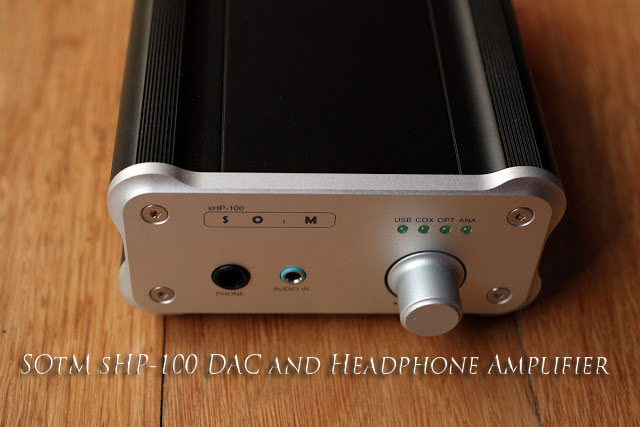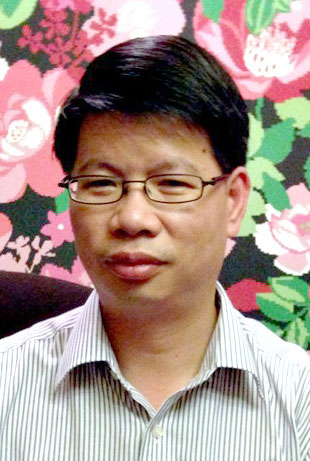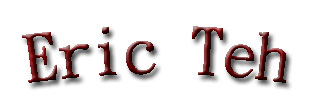SOtM sHP-100 DAC and Headphone Amplifier

Introduction
 This is my first personal experience with SOtM products. Although I have heard them a number of times during our local AV show (ISSE), somehow they never made their way into my listening room.
This is my first personal experience with SOtM products. Although I have heard them a number of times during our local AV show (ISSE), somehow they never made their way into my listening room.
SOtM is a Korean audio company that has a line of interesting products, focussed in the area of digital audio. I first read about SOtM products quite a while ago when computer audio was in its infancy. They were one of the go-to companies for products such as filters (for computer fans, SATA interfaces and the like) and audiophile USB cards.
Ray Ng from Raindrop Audio represents SOtM in Singapore and graciously supplied me with a number of products, including the sHP-100 which is the subject of this review.
Description
The sHP-100 is a diminutive USB DAC and headphone amplifier. Two additional digital inputs (coaxial and Toslink optical), and a single analog input (3.5 mm stereo mini-jack) are also offered. A variable line output (controlled by the volume knob in front) allows the sHP-100 to be used as a preamp. The volume knob does multiple duty as an input selector and mute switch – a brief press cycles inputs while a longer hold operates the mute switch. Front panel LEDs indicate the active input. Frankly, I would also have liked some indicators to show sampling rate and DSD operation too.
Flipping the unit over, two toggle switches set fixed output mode (bypassing the volume knob for the RCA line outputs) and the impedance range of your partnering headphones.
The sHP-100 can be powered via its USB input, or via a 9VDC jack. SOtM does not provide any power supply as a standard, although users can purchase the optional mBS-d2s battery power supply.
An AK4113 digital receiver chip from Asahi Kasei handles the coaxial and Toslink optical inputs, while an XMOS chipset takes care of the USB input. The sHP-100 uses the CS4398 DAC from Crystal Semiconductor. The output stage is op-amp based (Texas Instrument’s LME49720 for the analog output, and TPA6102A2 for the headphone amp). The TPA6102A2 is rated for 1.5W of output power, which should be plenty for almost any pair of headphones out there.
Some quick words about the mBS-d2s battery power supply – identical in size to the sHP-100, this power supply packs two batteries and an intelligent charging circuit. Operation could not be simpler. Connect it to the supplied switched mode wall-wart, and the charging circuit will activate and shut-off when required. One battery supplies power, while the other is charged automatically. LEDs indicate the status of the two batteries packs – whether they are supplying power, being charged, or close to exhaustion. To test the capacity of the battery cells, I disconnected the charger – both batteries were exhausted when I left the sHP-100 powered up overnight. The mBS-d2s is meant to be hooked up to the charger permanently – the charging circuit is isolated from the battery in use to prevent any sonic degradation. In other words, you are always good to go ! The battery pack outputs 6V to 9V DC.
Sound Quality
Ray asked me to try the sHP-100 through it’s fixed line-level outputs on my main system. I was hesitant – surely that was asking a little too much from this tiny box with it’s modest price tag ?
I powered the sHP-100 up, let it warm up for a good hour and waited for the anticipated sonic apocalypse. As an anti-climax, none of that happened and over the next few days, I found myself not really missing my Total DAC as much as I thought I would. In fact, I came to grow quite fond of this little unit.
I experimented with different ways of hooking up the sHP-100. I initially tried powering the sHP-100 through its USB input, but that was quick abandoned in favour of the mBS-d2s battery power supply. You could consider that to be mandatory for the sHP-100 to perform at its best, elevating it from “quite good” to “very special”.
I used the sHP-100 throughout my evaluation period exclusively with my Melco N1A audiophile NAS. The Melco only offers a USB output, so I did not try the SPDIF input on the sHP-100. Operation was incident free and the sHP-100 played my music files (both PCM and DSD) without any incident.
The sHP-100 impressed me with a very coherent presentation and performance that punched well above its price range. Tonally, it has a slightly sweet and laidback presentation. Detail retrieval was quite good and soundstaging had an open and wide quality.
I found the sHP-100 to be very pleasing to listen to. Recordings were always well-behaved (including naughty ones !) and easy to enjoy. From a critical point of view, both ends of the frequency spectrum are a bit soft sounding – the bass does not extend to the depths of much more expensive equipment, and neither would the sHP-100 be described as the airiest of performers. The smooth midrange quality also muted the attack of brass instruments and the violin. While the sHP-100 was quite fleet-footed in the rhythm department, it did not quite have the bass impact and intensity required if electronic dance music is your kind of thing.
The interesting thing is that none of this really mattered after a few minutes of listening to the sHP-100. It communicated the musical message clearly, and you could relax and enjoy yourself. On this front, it succeeds where a lot of more expensive equipment do not.
Some quick words on the headphone stage of the sHP-100. It is quite decent – good enough that you should be able to dispense with an entry or mid-level headphone stage. I found the sonic character of the sHP-100 to be quite obvious through cans. My Beyer DT-880 (250 ohm version) can sound a bit clinical and lightweight, but the sHP-100 really added much needed sweetness and tamed down the treble a fair bit. One word of warning though, please try your cans with the sHP-100 if you will be using this primarily as a headamp. Paired with a Meze Classics 99, and with the low impedance switch selected, the pot noise was quite intrusive when adjusting the volume. This was hardly noticeable on my Beyer DT-880 though.
The story doesn’t quite end here. Ray also supplied me with the tX-USBhub and the iSO-CAT6 LAN filter. As you rightly guessed, the former is an audiophile USB hub, while the latter is a network filter. I’ll refer to them as the USB Hub and LAN Filter for short.
The USB Hub is USB 2.0 compliant and features an ultra low noise power supply regulator and precision clock circuit to minimise jitter. It can be powered by a DC power source of between 6.5 V and 9 V, which means that you can use the mBS-d2s battery power supply too. Two USB type A outputs are provided, both with a red switch that allows you to turn-off the 5V DC supply on the USB port if you so wish. SOtM cautions that only one port should be used for optimal sound quality. No drivers are required. Hook everything up, and the green LED lights up. Couldn’t be simpler.
The LAN Filter is designed to isolate the LAN signal and block noise. Both ends of this slim device is marked. One end is marked “Router”, and the other end, “Device”. A short but very well made LAN cable is supplied. The router end of the device is meant to be hooked up to either the network hub or router. The device jack hooks up to the PC, NAS or music server. This is a passive device, and no power supply is needed.
The USB Hub is an easy win. I found the sound of the sHP-100 to be distinctly better when hooked up to the USB Hub. I tried powering the sHP-100 with the battery power supply, and the USB Hub with the wall-wart, and also the reverse. I also tried powering the sHP-100 with the USB Hub (i.e. using the +5V on the USB input), while the USB Hub was powered with the battery power supply – I personally liked this best. Bass was tighter and better defined, soundstaging and imaging became more precise, and there was a general improvement in refinement. You can confidently take out your check book for this.
Moving on to the LAN Filter, this is a tricky one. I loved some aspects of it’s performance, but some other aspects left me a bit cold. I experimented with the placement, and it seemed to be quite system dependent.
My usual network setup consists of a Cisco router / cable modem, hooked up to an Apple AirPort Extreme Wi-Fi base station. The rest of the wired connections in the house (including my Melco N-1A audiophile NAS) connect up to the Cisco. The LAN Filter was most effective connected in between the Melco and the Cisco router, with better inner detail and refinement, a silkier midrange and quieter background. The overall presentation was more laidback with the soundstage moving backwards a few feet. While the bass seemed tighter, it also felt drier and less bloomy. I also felt that there was a slight reduction in the “air” of recordings. I was quite surprised that the effect of the LAN Filter could be heard clearly, as Melco claims that its network ports are well isolated.
I removed the Melco from the system chain, and tried the LAN Filter between my Synology NAS and my Auralic Aries network streamer. While my observations were quite similar, the effect was a lot more obvious. My guess is that the Synology had a higher level of ” network noise” and benefited more from the LAN Filter. In this case, the LAN Filter was best placed directly between the NAS and streamer, compared to being interposed between the NAS and router.
I tried using the LAN Filter and USB Hub together, but I preferred the sound with just the USB Hub. Somehow, using both was too much of a good thing, and I felt that the presentation was too sweet, smooth and lacking in transient snap.
Conclusion
The sHP-100 really packs a punch. Consider this a knock-out. While plumping for the mBS-d2s and USB Hub significantly increase the cost of ownership, consider them mandatory to extract every ounce of performance from the sHP-100. That being said, the performance of the sHP-100 alone is already quite good, so feel free to upgrade in stages as funds permit.
Although I preferred my system without the LAN Filter, I could see it’s benefits and how it could work very well in some systems. A home audition would be recommended to see how it works out for you.
SOtM products are available at Raindrop Audio. A big thanks to Ray Ng of Raindrop Audio for making this review possible.

Specifications:
Price:
ShP-100 – $699.00
mBPS-d2s battery pack – $550
USB Hub – $699.00
CAT-6 LAN Filter – $350
Website: https://www.sotm-audio.com/
Raindrop Audio Pte Ltd
16 Waringin Park
Singapore 416329
Tel: +65 8228 8187
E-mail: info@raindropaudio.com
Eric also publishes his own blogspot out of Singapore entitled Eric’s Hifi Blogs (http://singaporehifi.blogspot.com/)
Stereo Times Masthead
Publisher/Founder
Clement Perry
Editor
Dave Thomas
Senior Editors
Frank Alles, Mike Girardi, Russell Lichter, Terry London, Moreno Mitchell, Paul Szabady, Bill Wells, Mike Wright, and Stephen Yan,
Current Contributors
David Abramson, Tim Barrall, Dave Allison, Ron Cook, Lewis Dardick, John Hoffman, Dan Secula, Don Shaulis, Greg Simmons, Eric Teh, Greg Voth, Richard Willie, Ed Van Winkle, Rob Dockery, Richard Doran, and Daveed Turek
Site Management Clement Perry
Ad Designer: Martin Perry





Be the first to comment on: SOtM sHP-100 DAC and Headphone Amplifier